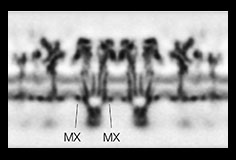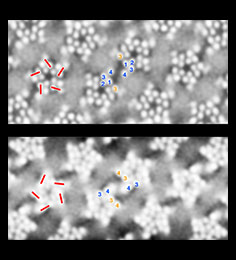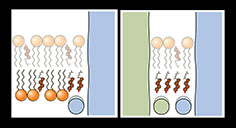Cholesterol microdomains
Cholesterol plays a vital role at the neuromuscular junction. In addition to enabling ACh receptors to function fully as ion channels, it forms microdomains - bridges of closely packed, rigid sterol groups that link one channel to the next.
The microdomains promote cooperativity between neighbouring channels. Thus the monomer channels comprising the microdomain-linked δ-δ dimer open and close in synchrony, rather than act as independent units (Schindler et al., 1984). Multiple synchonised gating also occurs. Such coordination of ion channel activity would enhance the ACh-sensitivity and magnitude of the postsynaptic response.
ACh receptors harbour motifs that stabilise the microdomains and help to create the distinct arrangements seen in the two leaflets of the bilayer. One is a transmembrane helix (M4) which has an affinity for cholesterol and tilts outward into the lipids; another is a submembrane helix (MX, missing from the early structural models) which sterically entraps cholesterol.
Key publications:
Unwin, N. Protein-lipid architecture of a cholinergic postsynaptic membrane. IUCrJ 7, 852-859 (2020). (pdf)
Unwin, N. Protein-lipid interplay at the neuromuscular junction. Microscopy 284, 1-6 (2021). (pdf)



